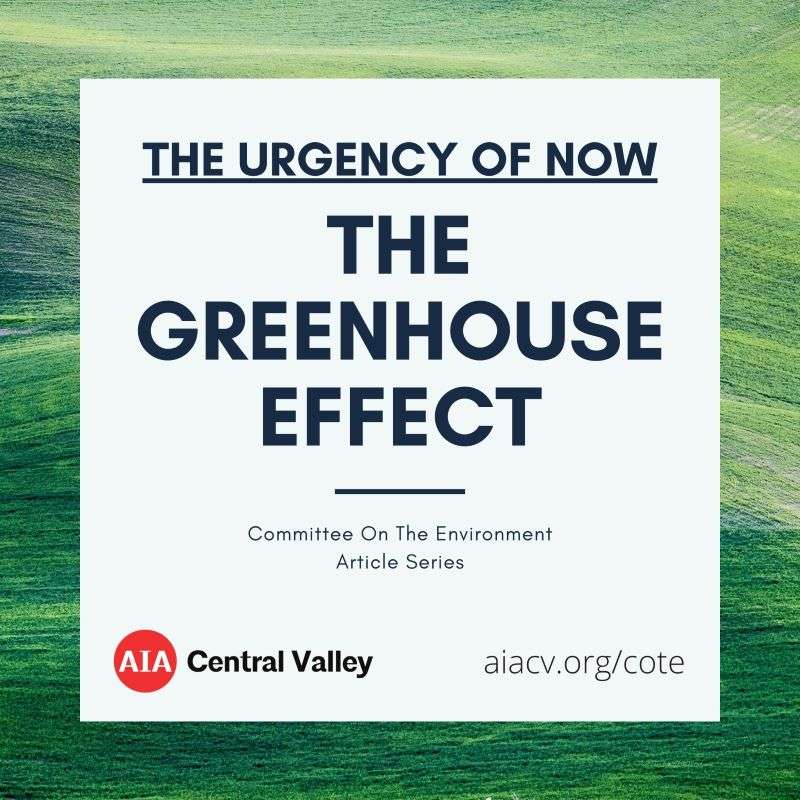
By Jamie Jang, Assoc. AIA
If we’re going to fix climate change, then we should understand it. The concepts in this article may be review for some, while others may not consider climate science to be reliable. Wherever you lie on the spectrum, I hope you read on because we need a starting point from which discussions can begin.
Fact number one: this is hard to understand in a deep, tangible, and intrinsic way. To begin, let’s separate The Greenhouse Effect from all the other terms out there, like “climate change” and “global warming”. These other terms describe the result, but the greenhouse effect is the process, and the subject of this article.
It all starts with the Sun – our beautiful massive ball of cosmic lava ninety-four-million miles away. Violent combustions within the Sun radiate a diverse array of energy in all directions, a miniscule fraction of which is headed for Earth. It takes eight minutes for those rays of sunshine to reach our atmosphere. When they do, one of three things happens (depending on their wavelength); the atmosphere reflects, absorbs, or transmits the solar energy. All life on Earth is powered by the Sun’s energy and the way our atmosphere filters it. In order to understand the greenhouse effect, we must first examine how our atmosphere interacts with the different types of energy that it encounters.
What are these “different types of energy”? Scientifically, it’s known as “solar radiation,” which is classified from longest to shortest wavelength; radio waves, infrared radiation, visible light, ultraviolet radiation, X-rays, and gamma rays. It is confusing that “waves”, “radiation”, “light”, and “rays” all describe a different class of the same thing, radiation. So, what is radiation? It is light and heat. They are the same thing. The easiest way to understand this is to walk outside into the sunshine. It is both bright to your eyes (light) and warm on your skin (heat). Together, light and heat are radiation, a form of energy.
An important side note (for those who forget high school physics): the First Law of Thermodynamics states that energy can never be created or destroyed. Energy simply changes form. To understand this, think about burning a log. The log is made of chemical bonds which store “chemical energy.” Burning the log releases this energy as radiation. The log’s mass seemingly vanishes as it is converted into heat and light.
Solar radiation of every wavelength strikes our atmosphere and gets filtered by it. X-rays and gamma rays are completely blocked. A small amount of ultraviolet radiation and infrared radiation passes through, but most of it gets absorbed or reflected. Virtually all visible light and radio waves pass through. This filtered concoction of radiation strikes our oceans, mountains, glaciers, forests, farms, deserts, and cities. When sunlight strikes a glacier, almost all of it is reflected back up where it once again passes through the atmosphere and into outer space. When sunlight strikes plants, which cover much of our land and our oceans, an amazing thing happens. The solar energy combines with carbon dioxide and water to make plant tissue – leaves, stems, and roots. Plants are nature’s alchemists and appreciating the miracle of a leaf will make a hippie out of anybody.
When sunlight strikes the exposed rock of our mountains or the concrete of our cities, most of the energy gets absorbed. However, rocks are not alchemists. Instead, the energy is radiated back out into the atmosphere as infrared radiation. When I go swimming and lay on concrete under the sun to warm up, I’m feeling the direct solar radiation and heat from the concrete. The concrete heat is infrared radiation and it is flowing up into my body, or into the atmosphere which absorbs and reflects most of this Infrared radiation. It is this portion of heat, the infrared radiation that is trapped between Earth’s surface and the atmosphere, that creates what we call the Greenhouse Effect.
So, there it is. The Greenhouse Effect with only one mention of carbon dioxide! How is that possible? Why is carbon dioxide so important? Well, the sun is pretty much a constant. There are variations that get blamed for our warming climate, but that’s cherry-picking the data (or as I like to call it, “wrong”). It is overwhelmingly agreed upon by the scientific community that the cause of global warming is a change in the chemistry of our atmosphere. Increasing levels of carbon dioxide and methane increase the amount of infrared radiation that gets trapped. It is clear that the increase of greenhouse gases has coincided with the booming of industry. Soaring populations and extraction have burnt our forests and fossil fuels for over 150 years. This tremendous growth and pollution has significant and measurable impacts on our atmosphere and climate, and we are now the wiser.As the planet warms, the threats to our ecosystems and agricultural systems get really scary. Scientists have determined that the scariest effects will start around a warming of 1.5℃ above pre-industrial levels. To help us prevent that, they use a metric called the Carbon Budget. The third article in The Urgency of Now will explore these two ideas to help us frame our current situation and what needs to happen in the near-term future to give our grandchildren the best chance of life as we know it.
